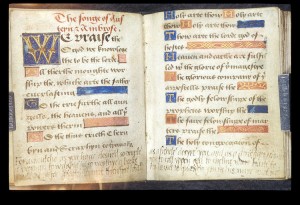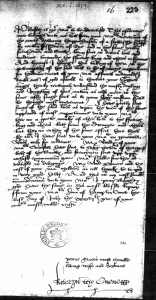Historian Stephan Edwards has very kindly written this guest article. His book, ‘A Queen of a New Invention: Portraits of Lady Jane Grey Dudley, ‘England’s Nine Days Queen’ was published in February 2015.
Writing in 2011, Dr Janell Mueller made the astonishing claim that the British Library’s Harley Manuscript 2342, commonly known as Lady Jane Grey’s Prayerbook, had been both written and decorated by the hand of Queen Katherine Parr (Figure 1) (1). Mueller further asserted that Parr had likely gifted the book to Lady Jane in September 1548 as she lay dying at Sudeley Castle from complications of childbirth (2). Mueller, a Distinguished Professor of English Language and Literature at the prestigious University of Chicago revealed these findings in Katherine Parr: Complete Works and Correspondence (University of Chicago Press, 2011). Mueller’s reputation as a leading scholar on female English authors of the early modern period lent significant authority to her claims. Yet Mueller did not offer any evidence or argumentation whatsoever to support her conclusions. Instead, she simply presented them as a fait accompli.
Prior to the publication of Mueller’s book in mid-2011, the Times Literary Supplement commissioned Professor James P. Carley of York University to review her study. Like Dr Mueller, Dr. Carley is a specialist in English language and literature, as well as in the history of manuscripts and the early Tudor period. Because he is not a specialist on Lady Jane Grey, however, Dr Carley contacted me in April 2011 as he was preparing his review, seeking my input regarding Mueller’s claims (3). I conveyed to Dr Carley my opinion that the handwriting on the first 137 folios was, in fact, quite different from Parr’s own handwriting, based on the evidence detailed below. Dr Carley had already reached the same conclusion, and in his review he wrote, “There is no resemblance to Katherine’s amateurish hand, and it would have been impossible for her to arrive at this level of professionalism of hand or illumination. Nor would she have wished to do so.” (4) Because of the space limitations imposed by the TLS, Dr. Carley was unable to present a comprehensive argument, but his opinion has nonetheless been accepted by the curators at the British Library, as holders of Harley 2342 (5).
Harley 2342 was written in a style of Gothic blacklettering known as lettera cursiva formata, a specialized style of handwriting not commonly utilized by any but professional scribes. No examples of writing in that style that can be firmly attributed to Parr are known. All extant examples of Parr’s own handwriting are instead in a style known as secretarial script. And while the two styles are markedly different in overall appearance, certain habitual hand motions occurring during writing and that result from muscle memory cause an individual writer to form letters in a similar manner even when writing in different styles (6). Careful comparison of the formation of individual letters in the prayerbook to the formation of the same letters in a document firmly attributed to Parr’s hand reveals critical differences (Fig. 2) (7). While the stems of the letter d are straight lines in the prayerbook, for example, the stems of Parr’s d’s are open loops. Similarly, the circular bodies of the letter g in the prayerbook all have an open top, while those in Parr’s handwriting are closed. And where the tails of the y’s in the prayerbook form a gentle and shallow curve to the right, the tails of Parr’s y’s form a much sharper and more pronounced curve to the right and continue upward. The handwriting seen in Harley 2342 unquestionably differs from Parr’s own hand, even when we account for the different writing styles used. Harley 2342 was certainly penned by a professional scribe.
Like the writing produced by professional scribes, manuscript illumination was also a very highly specialized skill and required equally specialized materials, as well as knowledge and mastery of techniques that could themselves be acquired only through years of apprenticeship with a master illuminator or limner. Pigments could not be purchased ready-to-use, for example. They were instead created by the individual limner using raw materials such as bone powder, juice of red nettle, mercury, and even “child’s urine.” These substances were mixed with turpentine, linseed and other “oils that make smoke,” egg yolk, gum arabic, or “water and grease of snails” prior to application to the vellum (8). And only a trained limner might know that certain materials should not be mixed. When lead white is mixed with verdigris, for instance, it produces a corrosive chemical that soon destroys any vellum or paper to which it is applied (9). Additionally, the decorations themselves are exceedingly small in scale, and working in miniature is a challenging skill to acquire (10). It is difficult to imagine Katherine Parr acting as her own amateur limner and successfully producing each of the many five-millimeter initials that appear repeatedly between folios 62 recto and 137 recto. The skill evidenced by the decoration of the prayerbook strongly indicates that those decorations were produced by a specially-trained professional illuminator or limner.
No connection between the book and Katherine Parr can today be verified. The book may as easily have been given to Jane by any of a number of family members, friends, or admirers. Jane is known to have received gifts of books from others, including a volume in Greek of the works of St. Basil presented to her by Mildred Cecil, wife of the up-and-coming William Cecil, future chief minister to Elizabeth I (11). And while Jane did live with Parr between about 1546 and the latter’s death late in 1548, Parr surrounded herself with a coterie of educated and wealthy women who shared both Jane’s and Parr’s religious interests. The group included Jane’s step-grandmother Katherine Willoughby Brandon, Dowager Duchess of Suffolk, Joan Champernowne Denny, and Mary Fitzalan, future Duchess of Norfolk, each of whom were renowned for their learning (12). A prayerbook would have been an entirely appropriate gift from any of these women to Jane. It has also been suggested that Jane may have commissioned the book herself, though that is perhaps doubtful in light of the fact that Jane was entirely financially dependent upon her parents throughout her short life (13).
While Dr Mueller’s claim that Lady Jane Grey’s prayerbook was written by Queen Katherine Parr and given to Jane Grey as a deathbed memento is certainly a romantic one, the evidence does not support such a claim. Instead, the book was almost certainly penned by a professional scribe and decorated by a professional illuminator. We cannot today know precisely when, how, or from whom Lady Jane acquired the tiny book.
Sources
1. Janel Mueller, ed., Katherine Parr: Complete Works and Correspondence (Chicago: University of Chicago Press, 2011), 489.
2. Mueller, Parr, 18n.51.
3. James P. Carley to J. Stephan Edwards, 11 April 2011, electronic correspondence.
4. James P. Carley, “Italic Ambitions: The Works of Henry VIII’s last queen and the problem of identifying exactly what Katherine wrote,” Times Literary Supplement 5644 (3 June 2011), 4.
5. See British Library Online Catalogue of Illuminated Manuscripts, Detailed Record For Harley 2342, under Notes. http://www.bl.uk/catalogues/illuminatedmanuscripts/record.asp?MSID=7220
6. Muscle memory occurs when a movement is repeated over time, creating a long-term muscle memory for that task that eventually allows it to be performed without conscious effort.
7. Cf. Katherine Parr to Henry VIII, 31 July 1544, National Archives, Public Record Office, SP 1/190, f.220.
8. A very proper treatise, wherein is briefly sett forthe the arte of limming….(London: Richard Tottill, 1571), f.12v.
9. Christopher de Hamel, British Library Guide to Manuscript Illumination (Toronto: University of Toronto Press, 2001), 78.
10. The incipit M on folio 5r, for example, is less than 20mm or three-quarters of an inch square, while the initials that begin to appear regularly on and after folio 62r are each approximately 5mm or one-fifth of an inch square.
11. National Archives, Public Record Office, State Papers 10/15/79, f. 1787–1789.
12. Susan E. James, Catherine Parr: Henry VIII’s Last Love (Stroud: Tempus Publishing, 2008), 127-129.
13. Carley, “Italic Ambition,” 5.






































